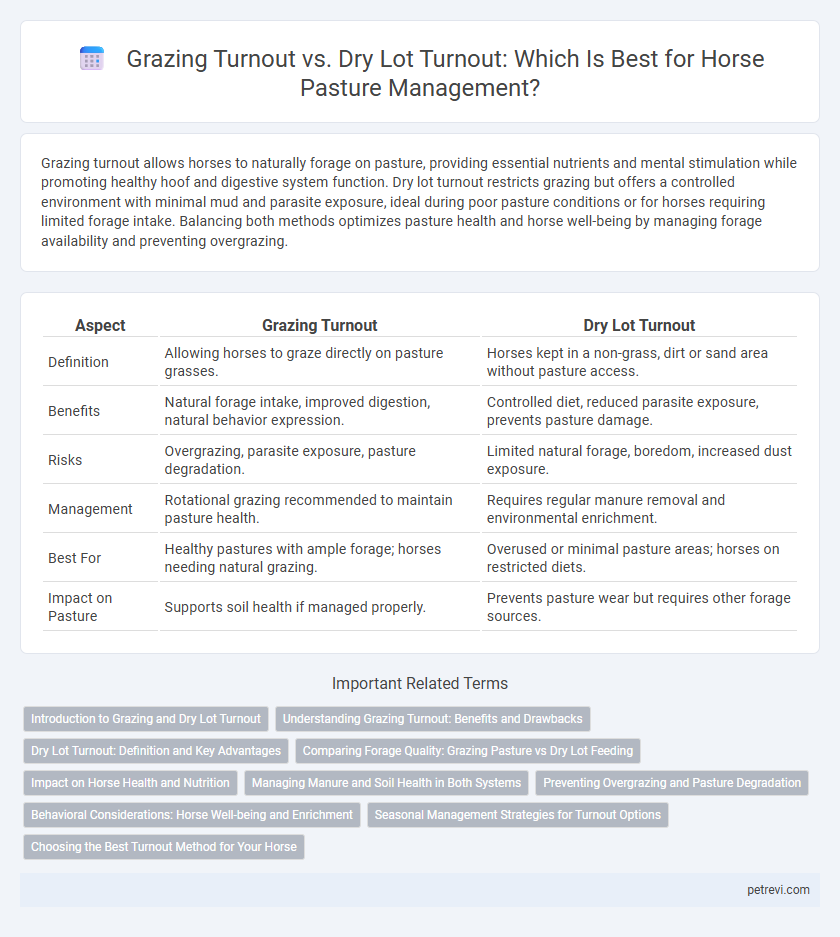Grazing turnout allows horses to naturally forage on pasture, providing essential nutrients and mental stimulation while promoting healthy hoof and digestive system function. Dry lot turnout restricts grazing but offers a controlled environment with minimal mud and parasite exposure, ideal during poor pasture conditions or for horses requiring limited forage intake. Balancing both methods optimizes pasture health and horse well-being by managing forage availability and preventing overgrazing.
Table of Comparison
| Aspect | Grazing Turnout | Dry Lot Turnout |
|---|---|---|
| Definition | Allowing horses to graze directly on pasture grasses. | Horses kept in a non-grass, dirt or sand area without pasture access. |
| Benefits | Natural forage intake, improved digestion, natural behavior expression. | Controlled diet, reduced parasite exposure, prevents pasture damage. |
| Risks | Overgrazing, parasite exposure, pasture degradation. | Limited natural forage, boredom, increased dust exposure. |
| Management | Rotational grazing recommended to maintain pasture health. | Requires regular manure removal and environmental enrichment. |
| Best For | Healthy pastures with ample forage; horses needing natural grazing. | Overused or minimal pasture areas; horses on restricted diets. |
| Impact on Pasture | Supports soil health if managed properly. | Prevents pasture wear but requires other forage sources. |
Introduction to Grazing and Dry Lot Turnout
Grazing turnout allows horses to access natural forage, promoting digestive health and mental stimulation through natural grazing behavior. Dry lot turnout restricts pasture access but offers controlled exercise space, minimizing overgrazing and parasite exposure. Effective pasture management balances these approaches to maintain optimal nutrition and land sustainability.
Understanding Grazing Turnout: Benefits and Drawbacks
Grazing turnout allows horses to access natural forage, promoting digestive health and mental well-being through natural grazing behavior. It supports pasture sustainability by utilizing grass resources efficiently but may increase the risk of parasite exposure and overgrazing if not managed properly. Proper rotational grazing and pasture monitoring are essential to maximize benefits and minimize health risks associated with grazing turnout.
Dry Lot Turnout: Definition and Key Advantages
Dry lot turnout refers to the practice of allowing horses access to a confined, non-grass area equipped with ample space, shade, and water, designed to prevent overgrazing and soil erosion. This method supports hoof health by offering firm, dry footing while enabling controlled exercise and socialization without the risks associated with pasture grasses. Key advantages include reduced parasite exposure, minimized mud-related injury risk, and improved pasture longevity through rest and regeneration periods.
Comparing Forage Quality: Grazing Pasture vs Dry Lot Feeding
Grazing turnout provides horses with access to fresh, nutrient-rich forage that supports natural grazing behavior and promotes digestive health through continuous intake of fiber. In contrast, dry lot turnout typically involves feeding harvested forage or hay, which can vary in quality and may lack the diversity and freshness found in pasture grass, potentially affecting nutrient intake and horse health. For optimal pasture management, maintaining high-quality, well-managed grazing areas ensures consistent forage quality, while dry lot feeding requires careful selection and supplementation to meet nutritional needs.
Impact on Horse Health and Nutrition
Grazing turnout allows horses to access fresh pasture rich in essential nutrients and fiber, promoting digestive health and natural foraging behavior. Dry lot turnout limits forage intake but provides controlled feeding and reduces exposure to toxic plants or parasites, helping manage weight and prevent laminitis. Balancing these methods supports optimal health by ensuring nutrient diversity while mitigating risks associated with uncontrolled grazing.
Managing Manure and Soil Health in Both Systems
Managing manure and soil health in grazing turnout systems involves distributing horse droppings naturally, which promotes nutrient cycling and organic matter incorporation but requires regular pasture rotation to prevent overgrazing and soil compaction. Dry lot turnout systems concentrate manure in a confined area, necessitating frequent manure removal and proper composting to avoid nutrient runoff and maintain soil quality. Both systems benefit from soil testing and amendments to balance soil fertility, support healthy forage growth, and reduce environmental impacts.
Preventing Overgrazing and Pasture Degradation
Grazing turnout allows horses to naturally forage, promoting soil health and maintaining pasture vitality by distributing grazing pressure and enabling regrowth. Dry lot turnout restricts grass consumption, preventing overgrazing but requires supplemental feeding and regular manure management to avoid soil compaction and nutrient buildup. Balancing grazing rotation with dry lot intervals optimizes pasture recovery, reducing degradation and supporting sustainable equine land management.
Behavioral Considerations: Horse Well-being and Enrichment
Grazing turnout allows horses to engage in natural foraging behavior, promoting mental stimulation and reducing stress by providing varied sensory experiences. Dry lot turnout limits grazing opportunities but can be enriched with toys, obstacles, and social interaction to prevent boredom and encourage movement. Behavioral well-being in pasture management hinges on balancing natural behaviors with environmental enrichment to maintain horse health and reduce stereotypic behaviors.
Seasonal Management Strategies for Turnout Options
Seasonal management of horse turnout involves optimizing grazing pasture during spring and fall when grass growth peaks, while utilizing dry lot turnout in winter to prevent overgrazing and soil damage. Grazing turnout promotes natural foraging and exercise, yet requires rotational grazing to maintain turf health and avoid pasture depletion. Dry lot turnout offers controlled nutrition and reduces mud-related hoof issues during wet seasons but necessitates supplemental feeding and cleanup routines.
Choosing the Best Turnout Method for Your Horse
Choosing the best turnout method for your horse depends on pasture quality, horse health, and management goals. Grazing turnout promotes natural foraging behavior and supports digestive health but requires well-managed pasture to prevent overgrazing and parasite buildup. Dry lot turnout offers controlled exercise and reduces pasture damage, making it ideal for horses with weight management issues or sensitive environments.
Grazing Turnout vs Dry Lot Turnout for Horse Pasture Management Infographic

 petrevi.com
petrevi.com